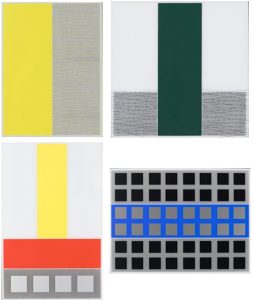 Roy Lichtenstein
Roy Lichtenstein
Nude, from Brushstroke Figures
1989
Lithograph, Waxtype, Woodcut and Screenprint
56 1/4 x 32 1/2 in.
Edition of 60
Pencil signed, dated and numbered
About the work:
The Nude and the Brushstroke are two classic and timeless pillars of Art History. The Nude figure has been used throughout time in art to express the ideals of the female and male bodies. The theme might evoke Boticelli’s The Birth of Venus or Michelangelo’s David, masterpieces for their representation of anatomical proportions as well as the technical skill required to produce them. The Brushstroke can be deemed the most basic and central element in two-dimensional art, yet it is hardly the first technique that comes to mind when considering Pop Art.
Roy Lichtenstein, one of Pop Art greats, strove to leave as little a trace of his hand in his work. His works carry a distinctive, mechanical style derived from mass printing, leading to his name becoming synonymous with popular comic-book imagery, Ben-Day dots and a primary color palette. Ironically, Lichtenstein began his career exploring abstract expressionism, a movement he would revisit at great length.
Abstract expressionism employed the brushstroke as a vehicle to communicate feelings with spontaneous motion. Lichtenstein, who always approached his art-making with humor, turned the spontaneous brushstroke on its head.
In 1989, the artist released his Brushstroke Figures series, from which this week’s Work of the Week! (WOW!) Nude stems.
Nude, from Brushstroke Figures is a playful balance between Abstract Expressionism and Lichtenstein’s brand of Pop, making the techniques used to be the focal point of the work over the subject. The center piece of Nude is composed of brushstroke-like elements, depicted as though created with a brush. These strokes, however, are the complete opposite of the abstract expressionist stroke. They are a methodically planned artistic operation, a time-consuming task made to appear as if produced in an instant. The painterly-like strokes lend to the piece a dense abstract complexity, which emphasizes the brushstroke over the subject it is used to depict.
The work also carries the unmistakable trademark characteristics of a Lichtenstein: Ben-Day dots and slanted, alternating white and red lines, in addition to Lichtenstein’s interpretation of the brushstroke, simulated in a uniform color and flat finish.
Lichtenstein takes away from the subject matter through the painterly brushstrokes, but simultaneously brings our attention back to it through his use of the slanted red and white lines as a background. This feature has an optical effect of making the subject appear as though it is floating in a three-dimensional space, entirely detached from from its setting. Every element of this work is calculated and placed.
Lichtenstein was a was very innovative printmaker, and never shied away from experimenting. Nude, from Brushstroke Figures makes use of a variety of printing methods, lithography, woodcut, screenprinting, and waxtype, a process similar to screenprinting, where beeswax is used, rather than traditional printers ink. Lichtenstein experimented with materials to create more depth and interest, and in this case, asks the viewer to reconsider their preconceived notion of the nude.

 Fulvio Bianconi
Fulvio Bianconi Damein Hirst
Damein Hirst






